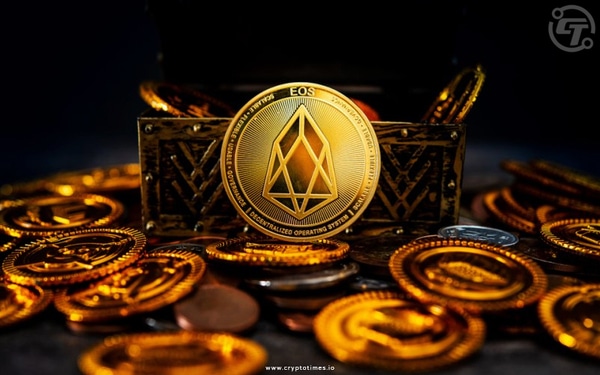Asset management is a complex and time-consuming process. It requires a deep understanding of the financial markets, as well as the ability to manage risk and make sound investment decisions. In recent years, blockchain technology has emerged as a potential solution to some of the challenges faced by asset managers. EOS is one such blockchain platform that offers a number of advantages for asset management, including speed, scalability, security, transparency, and interoperability.
By utilizing EOS, asset managers can tokenize assets, deploy smart contracts, and build decentralized exchanges, enhancing efficiency, accessibility, and investment opportunities. With its advanced capabilities, EOS has the potential to reshape the asset management landscape, empowering asset managers and delivering significant benefits to investors worldwide.
EOS is still in its early stages of development but it has the potential to become a major player in the asset management industry. You can also diversify your portfolio using immediateconnect.me to buy EOS and BTC.
Also Read: EOS vs. Bitcoin: Which Cryptocurrency is Right for You?
Advantages of EOS for Asset Management
1. Speed:
EOS is known for its exceptional transaction processing speed, which is crucial for asset managers who require real-time execution of trades and portfolio management.
According to EOS Network Monitor, EOS can handle thousands of transactions per second, far surpassing the capabilities of traditional financial systems. This high speed enables asset managers to seize market opportunities swiftly and respond to changing market conditions in a timely manner.
2. Scalability:
EOS is designed to be highly scalable, allowing it to handle a large number of transactions simultaneously. The scalability of EOS is demonstrated by its ability to support large-scale decentralized applications (dApps) and handle high transaction volumes without network congestion.
EOS achieves this through its unique consensus mechanism known as delegated proof-of-stake (DPoS), which enables fast and efficient block production. With this scalability advantage, asset managers can effectively manage portfolios for a growing number of clients without compromising performance.
3. Security:
Security is a paramount concern for asset managers, and EOS provides robust security measures to protect user funds and transactions. EOS utilizes DPoS, which involves a select group of trusted block producers who validate transactions and secure the network.
The consensus mechanism enhances security by reducing the risk of network attacks and providing a decentralized governance model. EOS has a proven track record of maintaining the security of its blockchain, making it a reliable platform for asset management.
4. Transparency:
EOS operates on a transparent blockchain, where all transactions are publicly visible and auditable. This transparency ensures that asset managers can provide their clients with real-time visibility into their investments.
According to the EOS Authority, there have been over 1.5 billion EOS transactions recorded on the blockchain, demonstrating the vast amount of transaction data available for analysis and monitoring. Investors can independently verify the accuracy of portfolio transactions, fostering trust and accountability in asset management practices.
5. Interoperability:
EOS is designed to be interoperable with other blockchains, allowing asset managers to access a wider range of assets and markets. The ability to interact with other blockchains opens up new investment opportunities and enables asset managers to diversify their portfolios.
For instance, EOS-based decentralized exchanges (DEXs) can facilitate seamless trading between EOS-based assets and assets from other blockchain networks, enhancing market access and liquidity.
Also Read: Blockchain Bridges: What They Are and How Do They Work?
Use Cases for EOS in Asset Management
EOS can be used for a variety of asset management use cases, including:
1. Tokenization:
EOS can be used to tokenize assets, which means that they can be represented as digital tokens on the blockchain. This can make it easier to trade and manage assets, and it can also open up new investment opportunities.
For example, a real estate fund could tokenize its assets and sell tokens to investors. This would allow investors to invest in real estate without having to buy a physical property.
2. Smart contracts:
EOS can be used to create smart contracts, which are self-executing contracts that can be used to automate transactions. This can be used to automate asset management tasks, such as rebalancing portfolios or executing trades.
For example, an asset manager could create a smart contract that automatically rebalances a portfolio when certain conditions are met. This would free up the asset manager to focus on other tasks.
3. Asset Back Lending:
EOS can be used to create asset-backed lending platforms, which allow borrowers to obtain loans using their assets as collateral. This can make it easier for borrowers to obtain loans, as they do not need to provide a credit history or other forms of collateral.
For example, a borrower could use an EOS-based platform to obtain a loan using their house as collateral. This would allow the borrower to obtain the loan without having to go through a traditional bank.
4. Decentralized Exchanges:
EOS can be used to create decentralized exchanges (DEXs), which are exchanges that do not require a central authority. This can make it easier to trade assets and it can also reduce the risk of fraud.
For example, an investor could use an EOS-based DEX to trade tokens without having to go through a centralized exchange. This would reduce the risk of the exchange being hacked or of the investor’s funds being stolen.
Also Read: EOS vs. Other Blockchain Platforms: A Comparative Analysis
Conclusion:
EOS is a promising platform for asset management. It offers a number of advantages, including speed, scalability, security, transparency, and interoperability. These advantages make EOS a good choice for a variety of asset management applications, such as tokenization, smart contracts, lending platform and decentralized exchanges.






